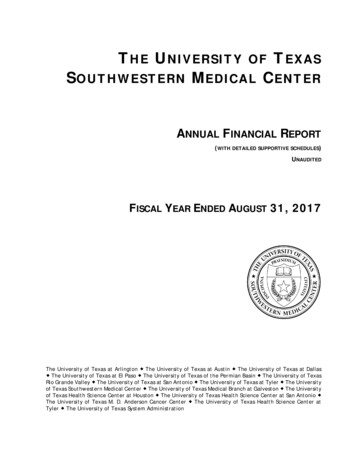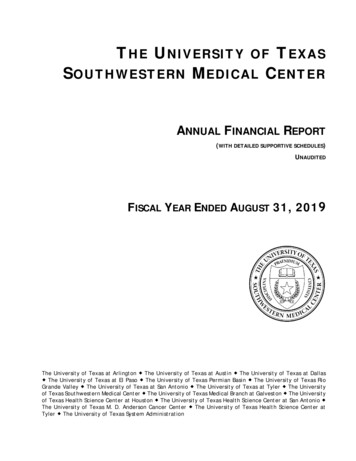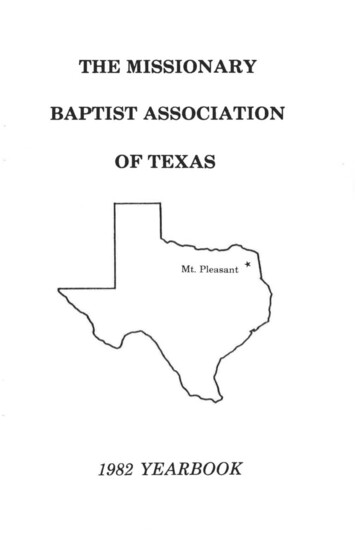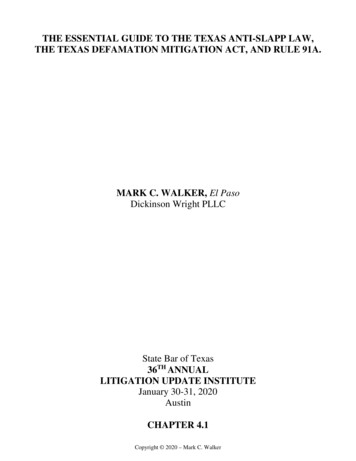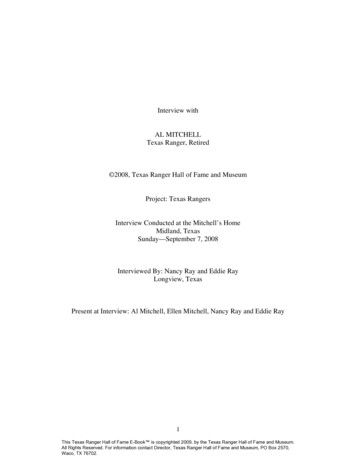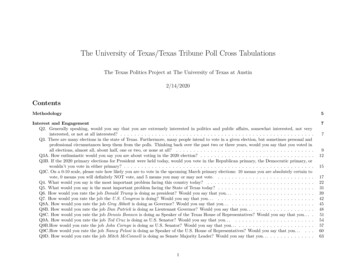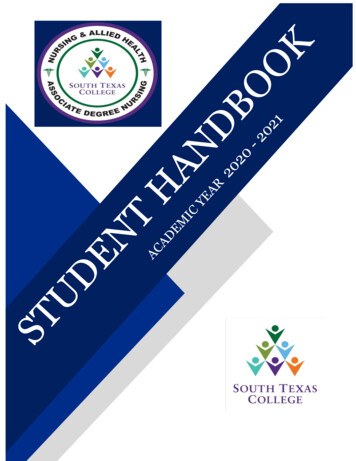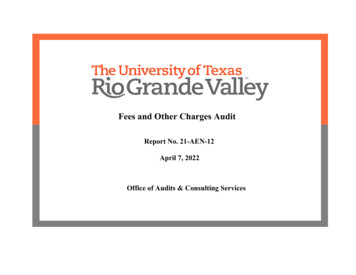
Transcription
University of Texasl{iqGrande ValleyFees and Other Charges AuditReport No. 21-AEN-12April 7, 2022Office of Audits & Consulting Services
The University of TexasRig Grande ValleyFees and Other Charges AuditBrownsville Edinburg HarlingenEXECUTIVE SUMMARYOverall Assessment:Overall, the majority of thestudent fees tested wereexpended in accordance withthe authorized purpose.However, opportunities existto improve monitoring feebalances, justifications foraccumulated balances, and useof fees.Background: Tuition and mandatory fees are the academic costs required of all students for generalenrollment. Tuition and fees are subject to change by legislative or regental action andbecome effective on the date enacted. The student fees assessed are authorized by statestatute; however, the University Administration and The University of Texas SystemBoard of Regents make the specific fee amounts and the determination to increase feesin accordance with state law.To determine whether student fees were expended in accordance with the authorizedpurpose and whether student fee accounts with unexpended balances at year-end haveprepared justifications for maintaining the balances in accordance with the cost recoverynature of the fees.Objectives:Scope/Period: All fees and other charges during fiscal year 2019 and 2020.Risk LevelsAppendix IPriorityHighMediumLowWe appreciate the assistanceprovided by UTRGV’smanagement and otherpersonnel. We hope theinformation and analysespresented in our report tions SummaryThe Planning & Analysis Office does not have a formal process to monitor and requireexplanations for large unexpended fee cost center balances. The Office does have feecost center guidance in UTRGV’s Annual Budget Instructions; however, it is not readilyavailable on the website.Late Payment and Late Registration fees are transferred to fund the Bursar’s Officeoperations. These incidental fees have specific purposes and are commingled with otherfunds. Therefore, we cannot determine whether the monies reasonably reflected theactual costs to the university of the services for which the fees were collected.Six ( 6,782) of the seven ( 36,782) expenses tested, 18% of the total expenses tested,were not aligned with the purpose of the Medical School Supplemental Application Fee,which is to defray the costs associated with processing applications for admission to theSchool of Medicine.None of the Medical Student Laboratory Fee Revenue collected has been spent since theinception of the fee. The total revenue collected as of FY2020 was 32,839.2 Page
The University of TexasRig Grande ValleyFees and Other Charges AuditBrownsville Edinburg HarlingenObservation DetailRecommendationManagement Action PlanCost Center BalancesWe reviewed FY2019 and FY2020 cost centerbalances for the fees selected for testing and anyoutliers.(Condition)The Planning & Analysis Office does not have aformal process to monitor and require explanations forthe large unexpended fee cost center balances. Manyof the fees have accumulated balances. During testingit was noted that there is a large Medical Service Feeaccumulated balance from one of the legacyinstitutions in the amount of 873,177.25. Thisamount was being accumulated for renovations on theBrownsville campus. While the Planning & AnalysisOffice has fee cost center guidance in its UTRGVAnnual Budget Instructions, it is not readily availableon its website.(Criteria)TEC Section 54.504 states that "The rate of anincidental fee must reasonably reflect the actual costto the university of the materials or services for whichthe fee is collected." Therefore, incidental fee revenueaccounts should not accumulate balances. In addition,UTRGV’s Annual Budget Instructions states “as arule-of-thumb, balances should not be allowed toaccumulate to greater than 20% of annual revenue.However, if well-documented, balances may beallowed to fund large cyclical purchases”.1. The Planning & AnalysisOffice should establish aprocess to monitor large feecost center balances. Theyshould develop an annualrequirement for cost centermanagers to provide formaljustifications or action plansto reduce large cost centerbalances. Additionally, theyshould have fee cost centerguidance readily availableon the website.1. Management Action Plan:Planning & Analysis will createformal guidance to establish an annualfee cost center balance monitoringprocess. The guidance will be postedon the Planning & Analysis website tobe followed by notification sent to feecost center managers and respectivefinance/budget contacts.Responsibility for monitoring willreside with the primary finance/budgetcontact for each division and/orcollege. These individuals currentlymonitor balances within their units.Documentation of the monitoringprocess, including justifications/actionplans for large balances, will remainon file in the division and collegeoffices.Planning and Analysis will remainavailable to assist with any questionswhich arise during annual monitoring.Action Plan owner: Director,Planning & AnalysisImplementation Date:6/30/20223 Page
The University of TexasRig Grande ValleyFees and Other Charges AuditBrownsville Edinburg HarlingenObservation DetailRecommendationManagement Action Plan(Cause)Large cost center balances have not been monitored.(Effect)Large unexpended balances could signify that the feesare set too high and should be re-assessed or other costcenters may be covering the costs associated withthese fees.Incidental FeesWe selected four fees for testing:1-Cost Center (31000219) New Student Orientation– To defray costs associated with orientationactivities.We determined fee expenditures were appropriate andsupported by adequate documentation.2-Cost Center (31000190) Late Payment Fee - Todefray costs associated with processing latepayments.3-Cost Center (31000187) Late Registration Fee To defray costs associated with registering studentsafter the deadline.(Condition)The revenue for the Late Payment Fee and the LateRegistration Fee are transferred and commingled tofund the Bursar’s Office operations. Therefore, we2. The Planning and AnalysisOffice should evaluateincidental fees and ensurethat fees are not combinedwith activities that are notconsistent with the purposeof the fee. Additionally, thePlanning and AnalysisOffice should determine if itis appropriate that all therevenue from these two fees(Late Payment Fee and LateRegistration Fee) should beused to cover the Bursar’sOffice Operations.2. Management Action Plan:Planning & Analysis will avoidcombining incidental fees in caseswhere different activities aresupported (e.g., the late paymentprocessing and late registrationprocessing activities described). Forthis reason, the Late Registration Feerevenue will be applied to Registraroperations which is more directlyimpacted by late registration than theBursar’s operation.Step 1: Necessary changes will beincorporated for FY 2023operating budget development.Step 2: The same changes will beapplied when funding FY 2022activities prior to FYE close.4 Page
The University of TexasRig Grande ValleyFees and Other Charges AuditBrownsville Edinburg HarlingenObservation DetailRecommendationcannot determine whether the monies reasonablyreflected the actual cost to the university of thematerials or services for which the fee was collected.Management Action PlanAction Plan Owner: Director,Planning & Analysis(Criteria)TEC Section 54.504 states that "The rate of anincidental fee must reasonably reflect the actual costto the university of the materials or services for whichthe fee is collected."Implementation Date:9/30/2022(Cause)These fees are transferred and commingled in a costcenter used for the Bursar’s Office operations.(Effect)Inappropriate use of the fee could signify that the feesis set too high and should be re-assessed.4-Cost Center (31000429) SupplementalApplication Fee – To defray the costs associatedwith processing applications for admission to theSchool of Medicine (SOM).(Condition)Six of the seven expenses tested were not aligned withthe purpose of the Medical School SupplementalApplication Fee. The inappropriate expenses were forThanksgiving Dinner for SOM students, SOM studenttravel, food for a workshop and pins.(Criteria)TEC Section 54.504 states that "The rate of anincidental fee must reasonably reflect the actual costto the university of the materials or services for which3. The Cost Center Manager andAssistant VP for Finance andAdministration should ensurethat the Medical SchoolSupplemental Application Feeis used for its intendedpurpose.3. Management Action Plan:Expense corrections posted inFebruary. The SOM is submitting aproposed adjustment to the feedescription to include wording onrecruitment, promotional relatedefforts and activities. In addition, staffassociated with processingapplications for admission to theSchool of Medicine are beingidentified along with effort to havepayroll costs funded by cost center.Action Plan Owner: Cost CenterManagerImplementation Date: 2/14/20225 Page
The University of TexasRig Grande ValleyFees and Other Charges AuditBrownsville Edinburg HarlingenObservation DetailRecommendationManagement Action Planthe fee is collected." UTRGV HOP ADM 10-703 –Accounting Policy Section C states that “Costcenter/project managers are expected to: 4. Know therestrictions applicable to each cost center/project anduse the funds in conformity with these restrictions and5. Expend funds within the approved fee, grant orcontract definitions and requirement in accordancewith state and federal rules and regulations”.(Cause)The cost center manager had a different understandingof the purpose of the fee and the proper use of the fee.(Effect)Inappropriate use of the fee could signify that the feesis set too high and should be re-assessed.Lab FeesWe selected one lab fee for testing.1-Medical Student Laboratory Fee - a charge togenerally cover the cost of laboratory materialsand supplies used by a student.(Condition)None of the Medical Student Laboratory Fee Revenuecollected has been spent. As of FY2020, a total of 32,839 has been collected.(Criteria)54.501. LABORATORY FEES. (a) An institution ofhigher education shall set and collect a laboratory fee4. The Cost Center Managerand the Assistant VP forFinance and Administrationshould ensure that theSchool of Medicine uses theMedical Student LaboratoryFee revenue for its approvedpurpose or reassess whetherthis fee is necessary.4. Management Action Plan:Prior year and current year laboratorymaterial and supplies expenses arebeing identified. Expense correctionswill be processed as needed. Movingforward, laboratory materials andsupplies will be charged to the costcenter.Action Plan owner: Cost CenterManagerImplementation Date: 3/11/20226 Page
The University of TexasRig Grande ValleyFees and Other Charges AuditBrownsville Edinburg HarlingenObservation DetailRecommendationManagement Action Planin an amount sufficient to cover the general cost oflaboratory materials and supplies used by a student.An institution other than a public junior college maycharge a laboratory fee in an amount that is not lessthan 2 nor more than 30 for any one semester orsummer term for a student in any one laboratorycourse, except that the amount of the laboratory feemay not exceed the cost of actual materials andsupplies used by the student.(Cause)SOM has not used any of the revenue collected.(Effect)Large unexpended balances could signify that the feeis too high and should be re-assessed.University Service FeeWe obtained a breakout of the cost centers that receiverevenue from University Service Fee and tested thefollowing three areas:1-Cost Center (31000239) Academic Advising Center2-Cost Center (31000213) Registrar Designated3-Cost Center (31000099) Center for Online Learningand Teaching TechnologyWe tested expenditures for these areas and determinedthat they were appropriate and supported by adequatedocumentation.7 Page
The University of TexasRig Grande ValleyFees and Other Charges AuditBrownsville Edinburg HarlingenObservation DetailRecommendationManagement Action PlanStudent Service FeeThe Student Advisory Committee advises thePresident on the allocation of the student service fee.We tested the following six student activities thatreceived revenue from this fee:1-Cost Center (46100024) Retention Initiative2-Cost Center (46100029) Leadership & Mentoring3-Cost Center (46100054) Chess4-Cost Center (46100056) Student Activities5-Cost Center (46100008) Drama6-Cost Center (46100005) Pep BandWe tested expenditures for all six areas anddetermined that they were appropriate and supportedby adequate documentation.8 Page
The University of TexasRig Grande ValleyFees and Other Charges AuditBrownsville Edinburg HarlingenAPPENDIX IRisk Classifications and DefinitionsPriorityHigh probability of occurrence that would significantly impact UT System and/or UT Rio Grande Valley.Reported to UT System Audit, Compliance, and Risk Management Committee (ACMRC). Priority findingsreported to the ACMRC are defined as “an issue identified by an internal audit that, if not addressed timely,could directly impact achievement of a strategic or important operational objective of a UT institution or theUT System as a whole.”HighRisks are considered substantially undesirable and pose a significant level of exposure to UT Rio GrandeValley operations. Without appropriate controls, the risk will happen on a consistent basis. Immediate actionis required by management in order to address the noted concern and reduce exposure to the organization.MediumRisks are considered undesirable and could moderately expose UT Rio Grande Valley. Without appropriatecontrols, the risk will occur some of the time. Action is needed by management in order to address the notedconcern and reduce the risk exposure to a more desirable level.LowLow probability of various risk factors occurring. Even with no controls, the exposure to UT Rio GrandeValley will be minimal. Action should be taken by management to address the noted concern and reduce riskexposure to the organization.9 Page
The University of TexasRig Grande ValleyFees and Other Charges AuditBrownsville Edinburg HarlingenAPPENDIX IICriteria & MethodologyCriteriaThe audit criteria included the Texas Education Code (TEC) Sections 54.504 Incidental Fees and 54.501 Laboratory Fees,University HOP ADM 10-703, as well as UT System Guidelines for fees and other charges. The audit methodology consisted ofgaining an understanding of the student fee process and reviewing policies and procedures. We conducted interviews, obtaineda list of all the tuition and fees that may be charged and the cost centers that were associated with the fees.MethodologyWe conducted this audit in conformance with the Institute of Internal Auditor’s International Standards for the ProfessionalPractice of Internal Auditing. Additionally, we conducted this audit in accordance with generally accepted government auditingstandards. Those standards require that we plan and perform the audit to obtain sufficient, appropriate evidence to provide areasonable basis for our findings and conclusions based on our audit objectives. We believe that the evidence obtained providesa reasonable basis for findings and conclusions based on our audit objectives. The Office of Audits and Consulting Services isindependent per both standards for internal auditors. These standards are also required by the Texas Internal Auditing Act.10 P a g e
The University of TexasRig Grande ValleyFees and Other Charges AuditBrownsville Edinburg HarlingenAPPENDIX IIIReport Distribution & Audit TeamReport DistributionDr. Michael Hocker, Dean of the School of Medicine, Senior VP Health RGVMichael Patriarca, Executive Vice Dean of the School of Medicine and Vice President of UT Health RGVMelba Sanchez, Assistant VP for Finance & Administration (SOM)Richard Wilson, Associate VP for Planning AnalysisMichael Mueller, Senior VP of Finance and PlanningUT System Audit OfficeGovernor’s OfficeOffice of Budget, Planning and PolicyState Auditor’s OfficeLegislative Budget BoardAudit TeamEloy R. Alaniz, Jr., Chief Audit OfficerNorma Ramos, Director of Internal AuditsIsabel Benavides, Assistant Director of Internal Audits11 P a g e
in accordance with state law. However, opportunities exist to improve monitoring fee . Objectives: To determine whether student fees were expended in accordance with the authorized balances, justifications for purpose and whether student fee accounts with unexpended balances at year-end have accumulated balances, and use


